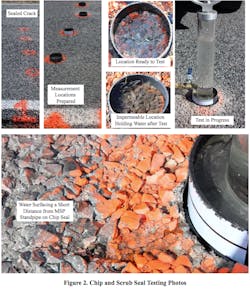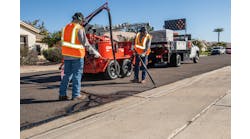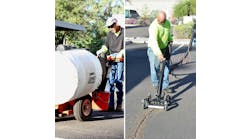In recent years, paving has witnessed an increased focus on preservation treatments, ranging from crack seals to chip seals to thin-lift overlays, and others. A number of these treatments are often collectively referred to simply as seal treatments. As the term implies, a principle objective of these treatments is to seal the existing pavement against further air and water infiltration to slow the rate of pavement oxidation and aging; however, a method to universally and reliably measure this infiltration has been missing. In an effort to address such issues, researchers in Mississippi have been evaluating a universal method for measuring water infiltration into multiple types of asphalt pavement surfaces such as dense graded asphalt (DGA), open graded friction course (OGFC), or a number of possible pavement preservation treatments (e.g. crack seal or chip seal).
The method presented here utilizes a simple, expedient device designated the Mississippi permeameter (MSP). Its primary appeal relative to other existing permeameters is that it can measure infiltration of multiple pavement surfaces, whereas others were developed primarily for DGA. Most permeability devices apply Darcy’s Law, which is violated several ways in the field. However, the MSP is a measurement of water infiltration using simple units of distance per unit of time (cm/min) that are comparable on the same scale over several orders of magnitude. For example, infiltration of 0.1 cm/min is 10 times less than 1 cm/min, which is 10 times less than 10 cm/min, and so on. As such, the MSP allows for the evaluation of pavement surfaces which differ in permeability by orders of magnitude, such as open graded friction coarse (OGFC) compared to chip seals, using the same general method, measurements, calculations, units and principles.
A considerable portion of this article is an abbreviation of a paper presented at the 97th Annual Meeting of the Transportation Research Board (1). Additional work has been conducted to further evaluate the MSP since the writing of that article and, as such, is included in this article.
Equipment
The MSP device dates to around 1975 when it was developed by the U.S. Army Corps of Engineers in Vicksburg, Miss. for use with OGFC. Starting in 2009, Mississippi State University (MSU) began making incremental improvements to the device. Most notably, the MSP was refined during Mississippi Department of Transportation (MDOT) State Study 250 into an equipment package consisting of a portable field system (see Figure 1) and a complementary laboratory system (see references 1 to 6 for more information). The acrylic standpipe in Figure 1a is the only component which needs to remain unchanged to maintain testing consistency.
The testing protocol is relatively simple. The standpipe is placed in position, loaded with 100 ± 5 lb, and filled with water to the 10 in. mark. The time required for the water level to fall to the 5 in. mark or the distance fallen in five minutes, whichever occurs first, is recorded. Generally, three replicate tests at a given test location are conducted. Water infiltration rate (Inf) in cm/min is reported as a reasonable index of permeability, capable of characterizing if and how much water penetrates a pavement.
Some preservation treatments such as chip and scrub seals exhibit a surface texture coarse enough that additional preparations are required for the MSP to form an adequate seal to the pavement surface. Figure 2 illustrates the coarse texture and shows a typical sealed crack in a chip or scrub sealed pavement (testing the sealed crack was of interest in this case).
The first preparation step is to cut a shallow groove with a 4 in. core bit through the seal treatment to the underlying pavement. Next, asphalt binder is heated and poured into the groove, and a 1.5 in. tall plastic ring is seated into the asphalt-filled groove. The MSP standpipe is set inside the ring, providing a watertight seal to the pavement, and testing is performed as normal. Additionally, two neoprene gaskets are often layered on the bottom of the standpipe to further promote adequate sealing. Figure 2 provides a close-up image of the MSP sufficiently sealed to a chip sealed crack, where water has infiltrated and flowed within the crack, before resurfacing 2 to 3 in. away.
Pavement and treatment types evaluated
Figure 3 illustrates the various pavement surfaces and preservation treatment types tested with the MSP to date, which encompass a range of physical characteristics. For example, OGFC is very open and permeable while chip seals are the most closed and least permeable with the roughest surface texture (i.e. most difficult to measure).
The MSP was initially developed for evaluating OGFC (Figure 3c). It was used to evaluate a south Mississippi interstate test section for approximately two years. Overall results showed Inf decreased over time from around 100 to 80-85 cm/min, and Inf was slightly higher between the wheel paths than directly in them (90 versus 85 cm/min, respectively).
In a second effort, the MSP was used to evaluate DGA placed at conventional thicknesses (Figure 3a) and thin-lift thicknesses (Figure 3b). For conventional-thickness overlays, the larger NMAS resulted in higher Inf compared to the smaller NMAS mixtures used for thin-lift overlays. Overall, conventional DGA exhibited Inf groupings of low, medium and high ranges largely corresponding to relationships observed in literature. Note that the testing of thin-lift overlays demonstrates a DGA application where in-place air voids cannot be reasonably determined. For thin-lift overlays, longitudinal joints were tested over a four-year period. Intact joints ranged up to 1.0 cm/min (slightly higher than the mat values), open or cracked joints exhibited Inf ranging from 100 to 125 cm/min, and joints that were beginning to open measured somewhere in between.
The most recent MSP testing efforts evaluated chip seals, scrub seals, a coal tar rejuvenator treatment and crack sealing. Around 20% of scrub and chip seals were completely impermeable, and Figure 3d shows that scrub seals on average yielded lower Inf values than chip seals. For the coal tar rejuvenator, Inf of the pavement mat prior to treatment ranged up to 0.8 cm/min. The mat, as well as several cracks that were tested, were impermeable following the treatment. In a somewhat similar manner, a pavement exhibiting no permeability had cracks with Inf from 0.4 to 1.1 cm/min; sealing the cracks reduced Inf to 0.2 cm/min or less.
Future activities
MDOT began performing network condition surveys in 1991, and developed decision trees in 2011 that include numerous treatments including rejuvenation, fog sealing, crack sealing, chip sealing, scrub sealing, ultra-thin overlays and combined treatments (scrub seal topped with an ultra-thin overlay, or chip/scrub seals topped with a fog seal). Generally, the past few years have seen reduced use of crack sealing and increased use of scrub seals and ultra-thin overlays. MDOT is interested in continued improvement of their decision tree selection process and improved performance of the treatments themselves. They have executed a comprehensive project with MSU named State Study 272 where some of the envisioned activities are to relate to the MSP. The intent is to identify means through which the MSP can help extend pavement life. Examples might include pre-treatment assessments used in decision trees, direct comparisons between a range of treatments, specified infiltration reductions from treatments, or other. State Study 272 is expected to lead to at least some standards and specifications changes within MDOT.
Apart from State Study 272, MDOT is exploring the concept of applying a fog seal over OGFC after some time in service to manage the rate of oxidation and aging. One concern with this treatment approach is a possibility of decreasing permeability, which MDOT envisions could be characterized with the MSP.
Conclusions
With an increasing focus on pavement preservation, the pavements industry is in need of some method to characterize permeability or water infiltration in a universal manner independent of the pavement surface type. The MSP has been vetted via field testing on a variety of asphalt pavement surfaces ranging from DGA and OGFC to a number of pavement preservation treatments like crack seals and chip seals. Through such testing, the MSP appears to be a viable method for further consideration.
Acknowledgments: MDOT funded State Studies 250 and 272, and Ergon Asphalt & Emulsions provided financial and other support. Permission to publish was granted by the director of the Geotechnical and Structures Laboratory, U.S. Army Engineer Research and Development Center.
References:
1. Cox, B.C., I.L. Howard, and C.A. Hopkins. Universal Method to Measure Water Infiltration into Asphalt Pavements Independent of Pavement Preservation Surface Treatment. Transportation Research Record: Journal of the Transportation Research Board, TRB Paper 18-01230 Accepted, 2018.
2. Cox, B.C., I.L. Howard, and J. Ivy. Evaluation of Approaches to Improve Longitudinal Joints in Mississippi Overlay Projects. Report FHWA/MS-DOT-RD-15-250-Volume 3, Mississippi Department of Transportation, Jackson, MS, 2015.
3. Cox, B.C., and I.L. Howard. Time Dependent Water Infiltration Resistance of Thin-Lift Asphalt Overlay Longitudinal Joints. Journal of Transportation Engineering, Part B: Pavements, Manuscript No. PVENG-177 Accepted, 2018.
4. White, T.D. Porous Friction Surface Course. Report No. FAA-RD-73-197, Federal Aviation Administration, Washington, D.C., 1975.
5. White, T.D. Field Performance of Porous Friction Course. Report No. FAA-RD-74-38, Federal Aviation Administration, Washington, D.C., 1976.
6. White, T.D., and J. Ivy. I-55 OGFC Field Permeability Testing. Report No. FHWA/MS-RD-09-201, Mississippi Department of Transportation, Jackson, MS, 2009.
------------------------
About the author:
Cox is a research civil engineer with the U.S. Army Engineer Research and Development Center. Middleton is an engineer with the Mississippi Department of Transportation research division. Pittman is a graduate research assistant at Mississippi State University. Howard is Materials and Construction Industries chair at Mississippi State University.



